The next-gen MacBook Pro with Retina Display Review
by Anand Lal Shimpi on June 23, 2012 4:14 AM EST- Posted in
- Mac
- Apple
- MacBook Pro
- Laptops
- Notebooks
GPU Performance
We’ve already established that NVIDIA’s Kepler architecture is fast, but the GeForce GT 650M used in the rMBP is hardly the best NVIDIA has to offer. The result however is a significant improvement in performance over the Radeon HD 6750M used in the previous generation model.
| 15-inch MacBook Pro Model | Mid 2010 | Upgraded Early 2011 | Upgraded Late 2011 | Retina |
| GPU | GeForce GT 330M | Radeon HD 6750M | Radeon HD 6770M | GeForce GT 650M |
| Cores | 48 | 480 | 480 | 384 |
| Core Clock | 500MHz | 600MHz | 675MHz | 900MHz |
| Memory Bus | 128-bit GDDR3 | 128-bit GDDR5 | 128-bit GDDR5 | 128-bit GDDR5 |
| Memory Data Rate | 1580MHz | 3200MHz | 3200MHz | 5016MHz |
| Memory Size | 512MB | 1GB | 1GB | 1GB |
The GT 650M offers fewer “cores” compared to the 6750M and 6770M used in previous MacBook Pros, but likely better utilization of the available hardware. NVIDIA also clocks the cores much higher in the 650M, the result is a ~20% increase in theoretical raw compute power.
The memory bandwidth story is also better on Kepler. While both the GT 650M and the 67xxM feature a 128-bit GDDR5 interface, Apple clocked AMD’s memory interface at 800MHz compared to 1254MHz on Kepler. The resulting difference is 80.3GB/s of memory bandwidth vs. 51.2GB/s.
The real world impact is most noticeable at higher resolutions, thanks to the tremendous amount of memory bandwidth now available. The other benefit from the new GPU is obviously things run a lot cooler, which as I’ve already shown to considerably reduce thermal throttling under load.
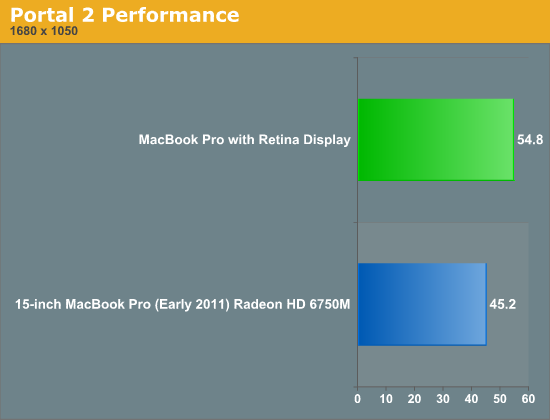
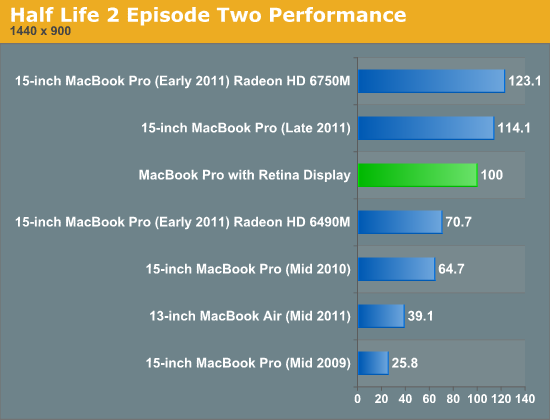
At 1440 x 900 we actually see a regression compared to the 2011 models, but differences in the AMD and NVIDIA GPU drivers alone can account for the difference at this hardly GPU bound setting. Look at what happens once we crank up the resolution:
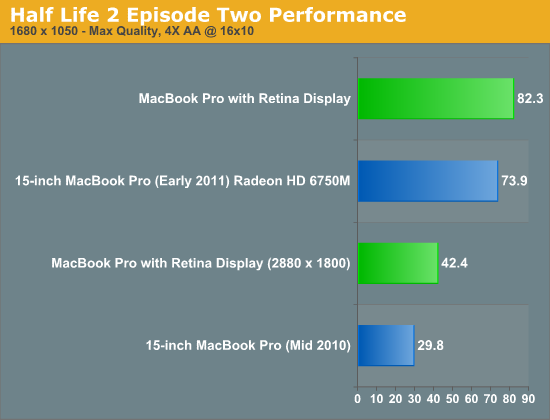
At 1680 x 1050 with 4X AA enabled we see a modest 11% increase in performance over last year's MacBook Pro. As I established earlier however, the rMBP will be able to more consistently deliver this performance over an extended period of time.
What's even more impressive is the 42.4 fps the GT 650M is able to deliver at the rMBP's native 2880 x 1800 resolution. Even though I ran the test with AA enabled I'm pretty sure AA was automatically disabled. At 2880 x 1800 the rMBP is able to outperform the two year old MacBook Pro running at 1680 x 1050. How's that for progress?
While the gains we've shown thus far have been modest at best, Starcraft 2 is a completely different story. Here for whatever reason the IVB + Kepler combination can be up to 2x the speed of last year’s models. I reran the tests both on the older and rMBP hardware to confirm, but the results were repeatable. The best explanation I have is Starcraft 2 is very stressful on both the CPU and GPU, so we could be seeing some thermal throttling on the older SNB + Turks hardware here.
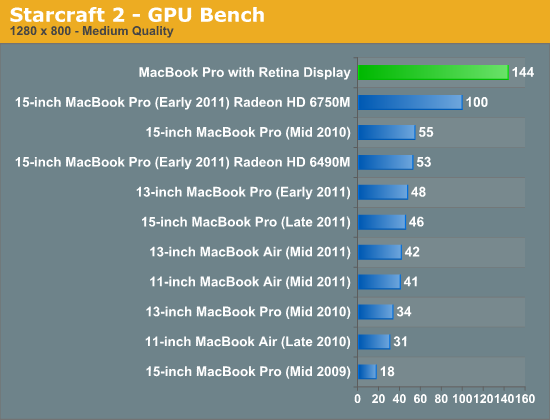
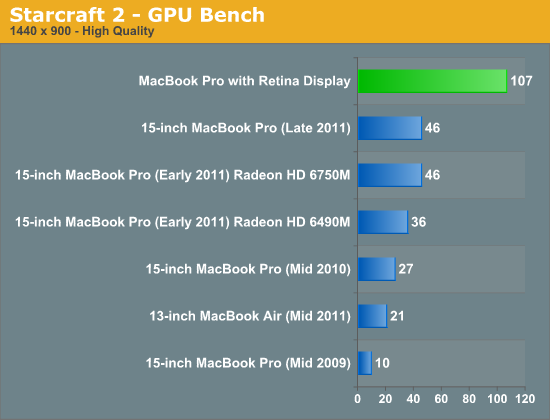
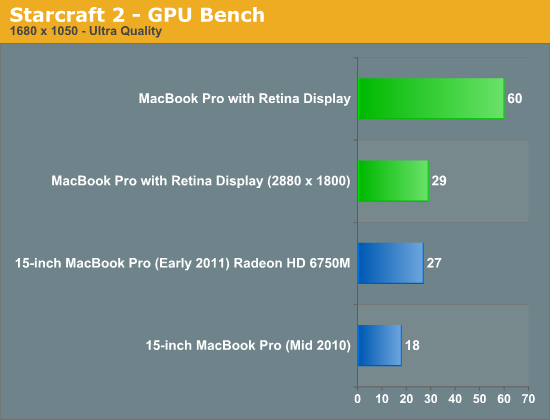
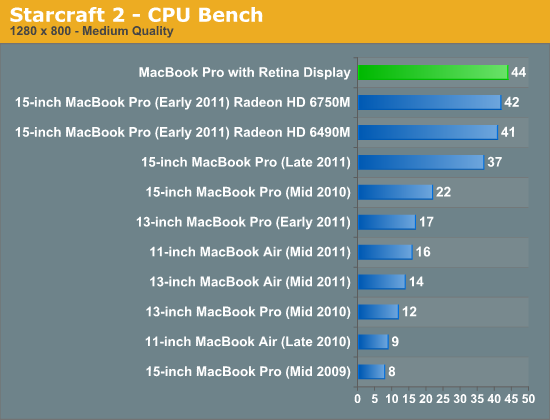
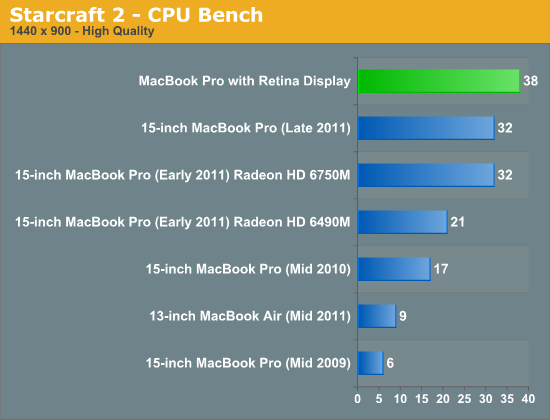

Once again we see playable, although not entirely smooth frame rates at 2880 x 1800. I've also included a screenshot of SC2 at 2880 x 1800 below:
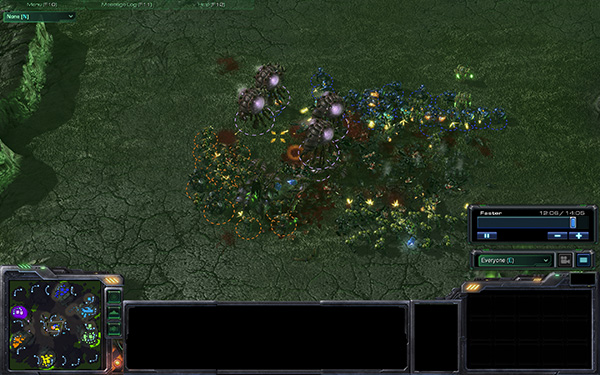
Starcraft 2 at 2880 x 1800, it's playable
Although gaming options continue to be limited under OS X, Diablo 3 is available and finally performs well on the platform thanks to the latest patches. Diablo 3 performance is appreciably better on the GT 650M compared to last year’s 6750M. There’s no FRAPS equivalent under OS X (free advertising to the first eager dev to correct that) so I have to rely on general discussion of performance here. The GT 650M is fast enough to drive the rMBP’s 2880 x 1800 panel at native resolution at playable frame rates, around 18 fps on average. Connected to an external 2560 x 1440 display however the GT 650M is fast enough to deliver around 30 fps in Diablo 3. For what it’s worth, performance under Diablo 3 is far more consistent with the rMBP than with last year’s MacBook Pro. I suspect once again we’re seeing the effects of thermal throttling under heavy CPU/GPU load that has been well mitigated by the move to more power efficient silicon.



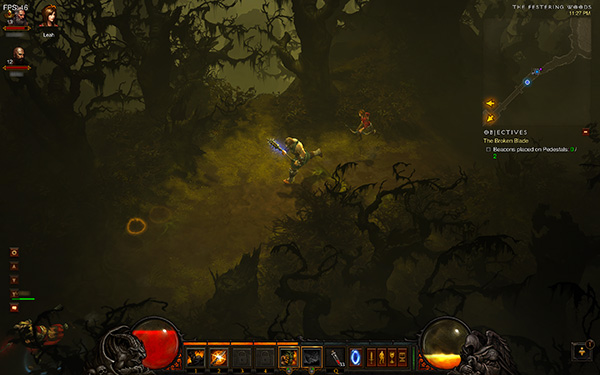








471 Comments
View All Comments
blackmagnum - Saturday, June 23, 2012 - link
New super resolutions are coming to notebook/ laptop computers. Thanks to Apple and their forward looking business sense. Wonder when it comes to PCs..... with Windows 8?Fleeb - Saturday, June 23, 2012 - link
I don't get it, I mean, what if another manufacturer thought of the idea first. I guess it wouldn't sell then.KoolAidMan1 - Saturday, June 23, 2012 - link
It probably wouldn't happen since other manufacturers are more focused on cutting corners and driving costs down as much as possible. Great for making their products more accessible but not so good for putting in bleeding edge technology.Johnmcl7 - Saturday, June 23, 2012 - link
Rubbish, there are plenty of other companies who are far more innovative than Apple whose machines look basic in comparison - Sony's older Z series had a very high resolution 13.1in 1080p screen, blu-ray writer, quad SSDs in RAID 0, integrated and discrete graphics card and the fastest of te dual core i7's while still smaller and lighter than Apple's 13in machines and that was a couple of years ago. Apple aren't even close to touching most of its technology and probably never will.John
tayb - Saturday, June 23, 2012 - link
Link to prove the existence of that product? It does not seem possible to put all of that into a 13" chassis that is thinner than the incredibly thin MB. Honestly, it doesn't possible to fit all of that into a 13" model in general.DeciusStrabo - Saturday, June 23, 2012 - link
http://store.sony.com/webapp/wcs/stores/servlet/Ca...and that's the third iteration of it, 1080p 13.3" - they did it 4 years ago already.
tayb - Saturday, June 23, 2012 - link
That doesn't have 4 SSDs, which was the biggest red flag in my eyes.Turbobusa311Hp - Saturday, June 23, 2012 - link
I remember that laptop. It didn't have 4 separate SSD's like you are thinking, but individual chips in a RAID 0. The Signature model was like $4700 though.DJTryHard - Saturday, June 23, 2012 - link
It had quad Raid 0, 4 separate chips.http://www.tomshardware.com/news/sony-vaio-z-quad-...
To summarize:
Core i7 620M
13.3inch 1080p matte panel
256gb ssd in quad raid 0
6gb ram
geforce GT 330M w/ 1gb vram
optical drive
and all this was in 2010...
extide - Saturday, June 23, 2012 - link
i7 620M is Dualcore Arrandale, not Quad.Anyways, yeah, that laptop is pretty sweet for it's day.